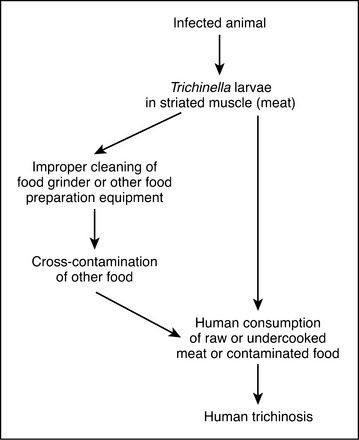TRICHINOSIS
Trichinosis, also known as trichinellosis, is a food-borne disease caused by a small parasite living in muscle tissue and eaten in raw or undercooked meat. The disease has traditionally been associated with eating undercooked pork, but strict federal regulations and education have greatly reduced the incidence of pork-related trichinosis in North America.
HOSTS
Carnivores and omnivores are most susceptible to developing trichinosis because they are most apt to eat infected meat. Herbivores, such as horses, can become infected if they eat feed that contains scraps of uncooked, infected meat. Some animals that can be sources of infection are pigs, wolves, ground squirrels, bears (grizzly, polar, and black), walruses, seals, whales, dogs, cats (wild and domestic), rats, foxes, and horses. In the past pigs were the primary sources of infection, because their diet consisted of uncooked garbage containing raw, infected meat. Today, packing plants are federally inspected, and it is against the law to feed raw garbage to pigs intended for market. Homegrown pigs fed raw garbage and never passing through a federally inspected packing plant can still be a source of infection.
TRANSMISSION
Most cases of trichinosis involve eating meat. Transmission occurs when an animal or a person eats raw or undercooked meat from an infected animal. The dormant larvae that were encysted in the muscle tissue (meat) are released from their cysts by stomach juices when they are ingested. From there they complete their life cycles and infect the muscles of the new animal or human host (Figure 47). In North America, people are usually dead-end hosts, as are some animals, such as dogs and horses, as they are not eaten on a regular basis.
Stay updated, free articles. Join our Telegram channel

Full access? Get Clinical Tree



